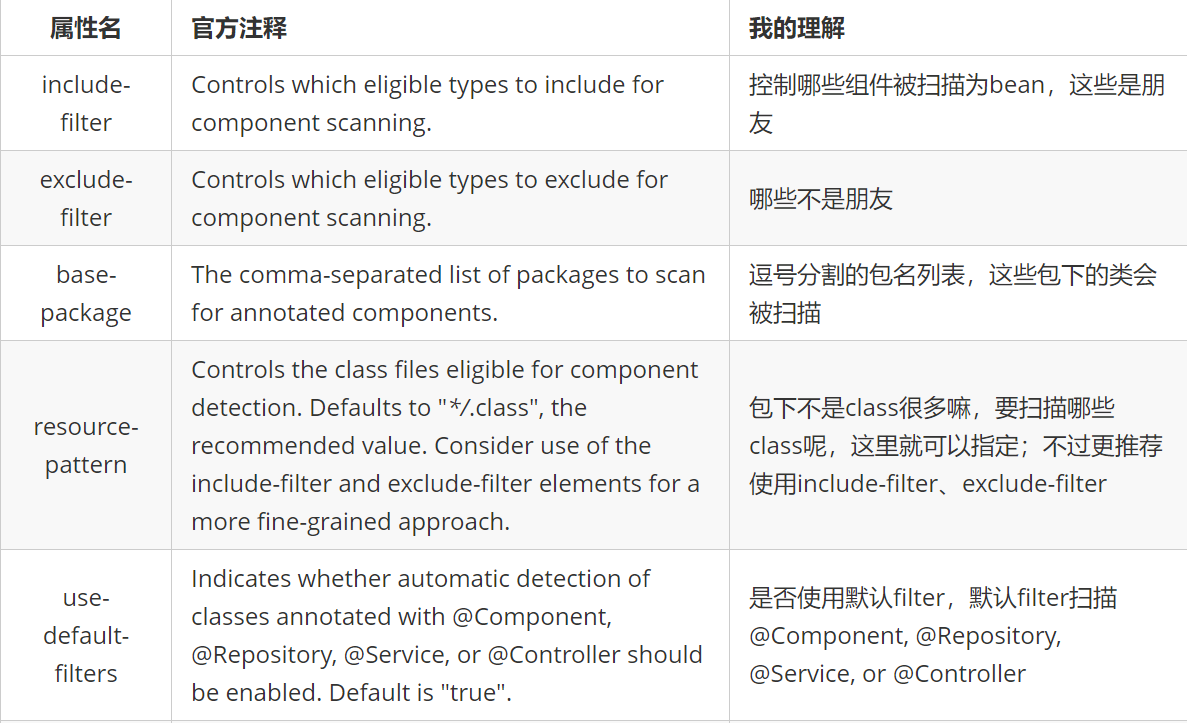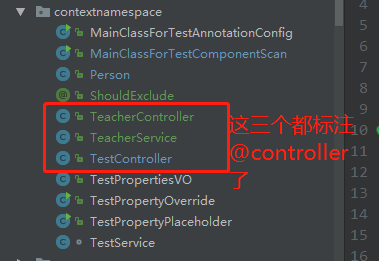曹工说Spring Boot源码(11)-- context:component-scan,你真的会用吗(这次来说说它的奇技淫巧)
写在前面的话
相关背景及资源:
曹工说Spring Boot源码(1)-- Bean Definition到底是什么,附spring思维导图分享
曹工说Spring Boot源码(2)-- Bean Definition到底是什么,咱们对着接口,逐个方法讲解
曹工说Spring Boot源码(3)-- 手动注册Bean Definition不比游戏好玩吗,我们来试一下
曹工说Spring Boot源码(4)-- 我是怎么自定义ApplicationContext,从json文件读取bean definition的?
曹工说Spring Boot源码(5)-- 怎么从properties文件读取bean
曹工说Spring Boot源码(6)-- Spring怎么从xml文件里解析bean的
曹工说Spring Boot源码(7)-- Spring解析xml文件,到底从中得到了什么(上)
曹工说Spring Boot源码(8)-- Spring解析xml文件,到底从中得到了什么(util命名空间)
曹工说Spring Boot源码(9)-- Spring解析xml文件,到底从中得到了什么(context命名空间上)
曹工说Spring Boot源码(10)-- Spring解析xml文件,到底从中得到了什么(context:annotation-config 解析)
工程结构图:

概要
本篇已经是spring源码第11篇,最近都在讲解:spring解析xml文件,到底获得了什么?获得了什么呢,感兴趣的可以挑选感兴趣的看;目前呢,已经讲到了context命名空间,接下来准备讲解component-scan,但是吧,这个真的是一个重量级的嘉宾,且不说原理,光是用法,就够我们感受感受啥叫主角了。
常规用法
我们在package:org.springframework.contextnamespace.componentscantest下存放了以下几个文件:
MainClassForTestComponentScan.java 测试类,包含main方法,不是bean
PersonTestController.java 使用了@Controller注解,里面使用@Autowired自动注入了PersonService
PersonService.java 使用了@Service注解
下边看下代码:
//定义一个bean
package org.springframework.contextnamespace.componentscantest;
import lombok.Data;
import lombok.extern.slf4j.Slf4j;
import org.springframework.beans.factory.annotation.Autowired;
import org.springframework.stereotype.Controller;
@Slf4j
@Data
@Controller
public class PersonTestController {
@Autowired
private PersonService personService;
}
// 再一个bean
package org.springframework.contextnamespace.componentscantest;
import org.springframework.stereotype.Service;
@Service
public class PersonService {
private String personname;
}
//测试代码
package org.springframework.contextnamespace.componentscantest;
import com.alibaba.fastjson.JSONObject;
import lombok.extern.slf4j.Slf4j;
import org.springframework.beans.factory.config.BeanDefinition;
import org.springframework.context.support.ClassPathXmlApplicationContext;
import org.springframework.util.MyFastJson;
import java.util.List;
import java.util.Map;
@Slf4j
public class MainClassForTestComponentScan {
public static void main(String[] args) {
ClassPathXmlApplicationContext context = new ClassPathXmlApplicationContext(
new String[]{"classpath:context-namespace-test-component-scan.xml"},false);
context.refresh();
List<BeanDefinition> list =
context.getBeanFactory().getBeanDefinitionList();
// 我自己的工具类,使用json输出bean definition
MyFastJson.printJsonStringForBeanDefinitionList(list);
Object bean = context.getBean(PersonTestController.class);
System.out.println("PersonController bean:" + bean);
}
}
xml文件如下:
<?xml version="1.0" encoding="UTF-8"?>
<beans xmlns="http://www.springframework.org/schema/beans"
xmlns:xsi="http://www.w3.org/2001/XMLSchema-instance"
xmlns:context="http://www.springframework.org/schema/context"
xsi:schemaLocation="http://www.springframework.org/schema/beans
http://www.springframework.org/schema/beans/spring-beans.xsd
http://www.springframework.org/schema/context
http://www.springframework.org/schema/context/spring-context.xsd">
<context:component-scan base-package="org.springframework.contextnamespace.componentscantest"/>
</beans>
输出:
PersonController bean:PersonTestController(personService=org.springframework.contextnamespace.componentscantest.PersonService@3e11f9e9)
可以看到,注入成功。
我代码里,其实还输出了全部的beanDefinition,我简单整理了一下,一共包含了如下几个:
| beanDefinition中的beanClass |
|---|
| org.springframework.context.annotation.CommonAnnotationBeanPostProcessor |
| org.springframework.contextnamespace.componentscantest.PersonService 我们自己的业务bean |
| org.springframework.contextnamespace.componentscantest.PersonTestController 业务bean |
| org.springframework.context.annotation.ConfigurationClassPostProcessor |
| org.springframework.beans.factory.annotation.RequiredAnnotationBeanPostProcessor |
| org.springframework.beans.factory.annotation.AutowiredAnnotationBeanPostProcessor |
| org.springframework.context.annotation.ConfigurationClassPostProcessor$ImportAwareBeanPostProcessor |
看来,一个简单的注解,背后却默默做了很多骚操作啊,除了自己的业务bean外,还有5个框架自带的bean,类型呢,从命名可以看出,都是些什么PostProcessor,有兴趣的,可以翻到我前一篇,里面讲解了AutowiredAnnotationBeanPostProcessor 。
阅读理解
我们从spring-context.xsd文件可以找到这个元素的官方说明。
Scans the classpath for annotated components that will be auto-registered as
Spring beans. By default, the Spring-provided @Component, @Repository,
@Service, and @Controller stereotypes will be detected. Note: This tag implies the effects of the 'annotation-config' tag, activating @Required,
@Autowired, @PostConstruct, @PreDestroy, @Resource, @PersistenceContext and @PersistenceUnit
annotations in the component classes, which is usually desired for autodetected components
(without external configuration). Turn off the 'annotation-config' attribute to deactivate
this default behavior, for example in order to use custom BeanPostProcessor definitions
for handling those annotations. Note: You may use placeholders in package paths, but only resolved against system
properties (analogous to resource paths). A component scan results in new bean definition
being registered; Spring's PropertyPlaceholderConfigurer will apply to those bean
definitions just like to regular bean definitions, but it won't apply to the component
scan settings themselves. See Javadoc for org.springframework.context.annotation.ComponentScan for information
on code-based alternatives to bootstrapping component-scanning.
我用我的425分压线4级翻译了一下:
扫描类路径下的注解组件,它们将会被主动注册为spring bean。默认情况下,可以识别以下注解:
@Component, @Repository,@Service, and @Controller。注意:这个元素隐含了context:annotation-config的作用,会默认激活bean class类里的@Required,
@Autowired, @PostConstruct, @PreDestroy, @Resource, @PersistenceContext and @PersistenceUnit 注解,这个功能也是一般默认需要的。将annotation-config属性,设为false,可以关闭这项功能,比如想要自己定制处理这些注解的BeanPostProcessor时。注意:你可以使用在包路径里,使用placeholder,但是只能引用system property。 component scan会导致新的bean definition被注册,Spring的PropertyPlaceholderConfigurer对这些bean,依然生效,但是,PropertyPlaceholderConfigurer 不能对 component scan生效。
如果要基于注解启动component-scan,请查看org.springframework.context.annotation.ComponentScan
这个只是元素本身的介绍,你知道,这个元素的属性还是有辣么多的,我们用一个表格,来看看其属性的意思:


annotation-config属性的作用
这个属性的意思是,本来,component-scan不是默认包含了context:annotation-config的功能吗,所以才能够识别并解析@Autowired等注解,那要是我们关了这个功能,再试试还能不能注入呢?
<context:component-scan
//这里设为false,关闭@autowired等注解的解析功能
annotation-config="false"
base-package="org.springframework.contextnamespace.componentscantest"/>
再次测试,输出如下:
PersonController bean:PersonTestController(personService=null)
可以发现,注入没成功。
而且,这次,我的beanDefinition输出语句显示,一共只有两个beanDefinition,就是我们定义的那两个业务bean。
这么看来,annotation-config的魔术手被我们斩断了,当然,代价就是,不能自动注入了。
use-default-filters属性的作用
本来这个属性的作用吧,从字面上看是说:
Indicates whether automatic detection of classes annotated with @Component, @Repository, @Service,
or @Controller should be enabled. Default is "true".
即:是否自动检测注解了@Component, @Repository, @Service,or @Controller 的类。
后面翻看了一下源码,更加明确了意义:
在component-scan这个元素的解析器里(ComponentScanBeanDefinitionParser),有个属性:
private static final String USE_DEFAULT_FILTERS_ATTRIBUTE = "use-default-filters";
关键代码如下:
protected ClassPathBeanDefinitionScanner configureScanner(ParserContext parserContext, Element element) {
XmlReaderContext readerContext = parserContext.getReaderContext();
boolean useDefaultFilters = true;
if (element.hasAttribute(USE_DEFAULT_FILTERS_ATTRIBUTE)) {
useDefaultFilters = Boolean.valueOf(element.getAttribute(USE_DEFAULT_FILTERS_ATTRIBUTE));
}
// 1.创建ClassPathBeanDefinitionScanner,下面的 2 3 4 等,代表一步一步跟代码的跳转顺序
ClassPathBeanDefinitionScanner scanner = createScanner(readerContext, useDefaultFilters);
...
}
// 2.
protected ClassPathBeanDefinitionScanner createScanner(XmlReaderContext readerContext, boolean useDefaultFilters) {
// 3
return new ClassPathBeanDefinitionScanner(readerContext.getRegistry(), useDefaultFilters);
}
// 3
public ClassPathBeanDefinitionScanner(BeanDefinitionRegistry registry, boolean useDefaultFilters) {
this(registry, useDefaultFilters, getOrCreateEnvironment(registry));
}
// 4
public ClassPathBeanDefinitionScanner(BeanDefinitionRegistry registry, boolean useDefaultFilters, Environment environment) {
// 5
super(useDefaultFilters, environment);
Assert.notNull(registry, "BeanDefinitionRegistry must not be null");
this.registry = registry;
// Determine ResourceLoader to use.
if (this.registry instanceof ResourceLoader) {
setResourceLoader((ResourceLoader) this.registry);
}
}
// 第5处,进入以下逻辑
public ClassPathScanningCandidateComponentProvider(boolean useDefaultFilters, Environment environment) {
// 如果使用默认filter,则注册默认filter
if (useDefaultFilters) {
registerDefaultFilters();
}
this.environment = environment;
}
下边就是核心了:
protected void registerDefaultFilters() {
/**
* 默认扫描Component注解
*/
this.includeFilters.add(new AnnotationTypeFilter(Component.class));
ClassLoader cl = ClassPathScanningCandidateComponentProvider.class.getClassLoader();
try {
// 这里可以看到,还支持 ManagedBean 注解
this.includeFilters.add(new AnnotationTypeFilter(
((Class<? extends Annotation>) cl.loadClass("javax.annotation.ManagedBean")), false));
logger.info("JSR-250 'javax.annotation.ManagedBean' found and supported for component scanning");
}
try {
// 还支持 javax.inject.Named 注解
this.includeFilters.add(new AnnotationTypeFilter(
((Class<? extends Annotation>) cl.loadClass("javax.inject.Named")), false));
logger.info("JSR-330 'javax.inject.Named' annotation found and supported for component scanning");
}
}
所以,这个属性的作用就是:假设指定的扫描包内有20个类,其中2个class注解了@component,则这两个类才是真正被扫描的类,至于具体的解析,这个属性就不关心了。
context:exclude-filter属性的作用
为什么不分析context:include-filter,因为假设某个类没有注解@component,按理说,是不加入扫描范围的;
如果我们的include-filter把这个类纳入范围,则还要自定义bean definition的解析逻辑才能将这个类变成bean。
我们这里有个demo,其中TeacherController和TeacherService是注解了ShouldExclude的。

xml如下:
<context:component-scan
use-default-filters="true"
base-package="org.springframework.contextnamespace">
// 我们这里使用了annotation类型,要把包含了ShouldExclude注解的,全部排除
<context:exclude-filter type="annotation" expression="org.springframework.contextnamespace.ShouldExclude"></context:exclude-filter>
// 这里使用regex类型,排除掉TestController
<context:exclude-filter type="regex" expression="org.springframework.contextnamespace.TestController"></context:exclude-filter>
</context:component-scan>
所以,上面的xml,我们可以将3个bean全部排除。
context:include-filter属性的作用
在前面,我们说,这个属性不好测试,但我想到也许可以这样测:
<context:component-scan
use-default-filters="false"
base-package="org.springframework.contextnamespace">
<context:include-filter
type="annotation"
expression="org.springframework.stereotype.Component"/>
<context:exclude-filter type="regex" expression="org.springframework.contextnamespace.TestController"/>
</context:component-scan>
use-default-filters 这里设为false,排除掉默认的@component的include filter;
但是我们在下面,再通过include-filter来达到同样效果。
<context:include-filter
type="annotation"
expression="org.springframework.stereotype.Component"/>
经过上述改造后,运行正常。
注:以上部分是前两天写的(代码要后边上传,在家里电脑上),以下部分是公司电脑写的,前面的代码在家里,忘记提交了。所以demo会略微不一样,不过不影响实验。
前面我说不好测试,但我发现还是可以搞。我们将会单独定义一个自定义注解:
package org.springframework.contextnamespace;
import org.springframework.stereotype.Component;
import java.lang.annotation.*;
@Target({ElementType.TYPE})
@Retention(RetentionPolicy.RUNTIME)
@Documented
// 大家注意,这里的@component我注掉了
//@Component
public @interface DerivedComponent {
/**
* The value may indicate a suggestion for a logical component name,
* to be turned into a Spring bean in case of an autodetected component.
* @return the suggested component name, if any
*/
String value() default "";
}
然后呢,下面这两个类我是使用上面的注解来标注了的:
@DerivedComponent
public class PersonService {
private String personname1;
}
@DerivedComponent
public class PersonTestController {
// @Autowired
@Resource
private PersonService personService;
}
xml如下:
<context:component-scan
use-default-filters="false"
base-package="org.springframework.contextnamespace.componentscan">
<context:include-filter type="annotation" expression="org.springframework.contextnamespace.DerivedComponent"/>
</context:component-scan>
有必要解释下:
use-default-filters="false":为true时,会将注解了@component或者@controller等注解的class包含进候选bean;这里设为false,就不会进行上述行为;
context:include-filter:这里呢,类型为注解,注解类就是我们自定义的那个。
总体意思就是,扫描指定包下面的,带有@DerivedComponent注解的类;忽略带有@component等注解的类。
这样设置,我们的测试程序会如何:
PersonController bean:PersonTestController(personService=org.springframework.contextnamespace.componentscan.PersonService@4f615685)
it works!没想到,这样都可以。
我们看看他们的bean definition:
{
"abstract":false,
"autowireCandidate":true,
"autowireMode":0,
"beanClassName":"org.springframework.contextnamespace.componentscan.PersonService",
"constructorArgumentValues":{
"argumentCount":0,
"empty":true,
"genericArgumentValues":[],
"indexedArgumentValues":{}
},
"dependencyCheck":0,
"enforceDestroyMethod":false,
"enforceInitMethod":false,
"lazyInit":false,
"lenientConstructorResolution":true,
"metadata":{
"abstract":false,
// 这里可以看到,注解确实是DerivedComponent
"annotationTypes":["org.springframework.contextnamespace.DerivedComponent"],
"className":"org.springframework.contextnamespace.componentscan.PersonService",
"concrete":true,
"final":false,
"independent":true,
"interface":false,
"interfaceNames":[],
"memberClassNames":[],
"superClassName":"java.lang.Object"
},
"methodOverrides":{
"empty":true,
"overrides":[]
},
"nonPublicAccessAllowed":true,
"primary":false,
"propertyValues":{
"converted":false,
"empty":true,
"propertyValueList":[]
},
"prototype":false,
"qualifiers":[],
"resolvedAutowireMode":0,
"resourceDescription":"file [F:\\work_java_projects\\spring-boot-first-version-learn\\all-demo-in-spring-learning\\spring-xml-demo\\target\\classes\\org\\springframework\\contextnamespace\\componentscan\\PersonService.class]",
"role":0,
"scope":"singleton",
"singleton":true,
"synthetic":false
}
具体原理,下节具体分析,主要呢,context:component-scan 的解析代码,主要就是负责收集beandefinition,
而上面这种自定义注解收集的方式的缺点在于,不能像@component等注解那样,有很多的属性可以设置。我们的自定义注解,只能是使用默认的beanDefinition配置,比如默认单例,等等。当然,你也可以直接使用和@component一模一样的属性,不过那也没啥必要了,对吧。
这部分的源码,我放在了:
最后这个自定义注解的内容,小马哥的spring boot编程思想里也提到了,在161页,我手边没有电子版本,所以抱歉了。
总结
component-scan,用了这么些年,看来真的只是用,里面的原理还是一知半解,经过上面的分析,我也自己系统梳理了一遍。大家看看有啥问题的,欢迎指出来,一起进步。
曹工说Spring Boot源码(11)-- context:component-scan,你真的会用吗(这次来说说它的奇技淫巧)的更多相关文章
- 曹工说Spring Boot源码系列开讲了(1)-- Bean Definition到底是什么,附spring思维导图分享
写在前面的话&&About me 网上写spring的文章多如牛毛,为什么还要写呢,因为,很简单,那是人家写的:网上都鼓励你不要造轮子,为什么你还要造呢,因为,那不是你造的. 我不是要 ...
- 曹工说Spring Boot源码(12)-- Spring解析xml文件,到底从中得到了什么(context:component-scan完整解析)
写在前面的话 相关背景及资源: 曹工说Spring Boot源码(1)-- Bean Definition到底是什么,附spring思维导图分享 曹工说Spring Boot源码(2)-- Bean ...
- 曹工说Spring Boot源码(13)-- AspectJ的运行时织入(Load-Time-Weaving),基本内容是讲清楚了(附源码)
写在前面的话 相关背景及资源: 曹工说Spring Boot源码(1)-- Bean Definition到底是什么,附spring思维导图分享 曹工说Spring Boot源码(2)-- Bean ...
- 曹工说Spring Boot源码(14)-- AspectJ的Load-Time-Weaving的两种实现方式细细讲解,以及怎么和Spring Instrumentation集成
写在前面的话 相关背景及资源: 曹工说Spring Boot源码(1)-- Bean Definition到底是什么,附spring思维导图分享 曹工说Spring Boot源码(2)-- Bean ...
- 曹工说Spring Boot源码(15)-- Spring从xml文件里到底得到了什么(context:load-time-weaver 完整解析)
写在前面的话 相关背景及资源: 曹工说Spring Boot源码(1)-- Bean Definition到底是什么,附spring思维导图分享 曹工说Spring Boot源码(2)-- Bean ...
- 曹工说Spring Boot源码(16)-- Spring从xml文件里到底得到了什么(aop:config完整解析【上】)
写在前面的话 相关背景及资源: 曹工说Spring Boot源码(1)-- Bean Definition到底是什么,附spring思维导图分享 曹工说Spring Boot源码(2)-- Bean ...
- 曹工说Spring Boot源码(17)-- Spring从xml文件里到底得到了什么(aop:config完整解析【中】)
写在前面的话 相关背景及资源: 曹工说Spring Boot源码(1)-- Bean Definition到底是什么,附spring思维导图分享 曹工说Spring Boot源码(2)-- Bean ...
- 曹工说Spring Boot源码(18)-- Spring AOP源码分析三部曲,终于快讲完了 (aop:config完整解析【下】)
写在前面的话 相关背景及资源: 曹工说Spring Boot源码(1)-- Bean Definition到底是什么,附spring思维导图分享 曹工说Spring Boot源码(2)-- Bean ...
- 曹工说Spring Boot源码(19)-- Spring 带给我们的工具利器,创建代理不用愁(ProxyFactory)
写在前面的话 相关背景及资源: 曹工说Spring Boot源码(1)-- Bean Definition到底是什么,附spring思维导图分享 曹工说Spring Boot源码(2)-- Bean ...
随机推荐
- Vue 双向数据绑定v-model
<!DOCTYPE html> <html lang="en"> <head> <meta charset="UTF-8&quo ...
- java 九个预定义Class对象
基本的 Java 类型(boolean.byte.char.short.int.long.float 和 double)和关键字 void通过class属性也表示为 Class 对象: Class类中 ...
- Argus--[优先队列]
Description A data stream is a real-time, continuous, ordered sequence of items. Some examples inclu ...
- P1093 铺地毯
题目描述 为了准备一个独特的颁奖典礼,组织者在会场的一片矩形区域(可看做是平面直角坐标系的第一象限)铺上一些矩形地毯.一共有 \(n\) 张地毯,编号从 \(1\) 到 \(n\) .现在将这些地毯按 ...
- 解决 npm run dev b报错 “'webpack-dev-server' 不是内部或外部命令,也不是可运行的程序 或批处理文件。”
摘自:https://www.cnblogs.com/laraLee/p/9174383.html 前提: 电脑已经安装了nodeJS和npm, 项目是直接下载的zip包. 在项目目录下运行“npm ...
- Webstorm 配置 Less编译
配置less编译
- tensorflow在文本处理中的使用——Word2Vec预测
代码来源于:tensorflow机器学习实战指南(曾益强 译,2017年9月)——第七章:自然语言处理 代码地址:https://github.com/nfmcclure/tensorflow-coo ...
- MockMvc control层单元测试 参数传递问题
GET: 1.路径参数@PathVariable 2.表单参数@RequestParam POST: 1.JSON请求体参数 @RequestBody 放: 1.路径参数@PathVariable 2 ...
- QP移植
以STM32平台为例,该单片机的ARM Cortex-M系列内核正是被QP长期支持,所以QP在ARM Cortex-M系列内核上已经有长时间的应用验证. 在配套书籍PSICC2中的例程为QP最原始的版 ...
- centos 下yum lock的解决办法
centos 下yum lock的解决办法 centos7下yum install的时候,报了一堆错误,如下: Another app is currently holding the yum loc ...
